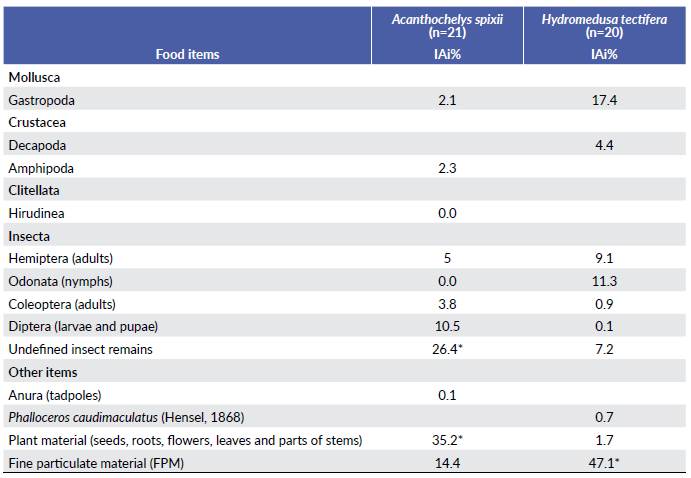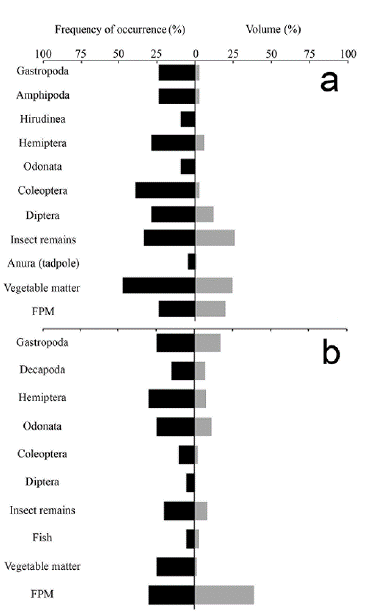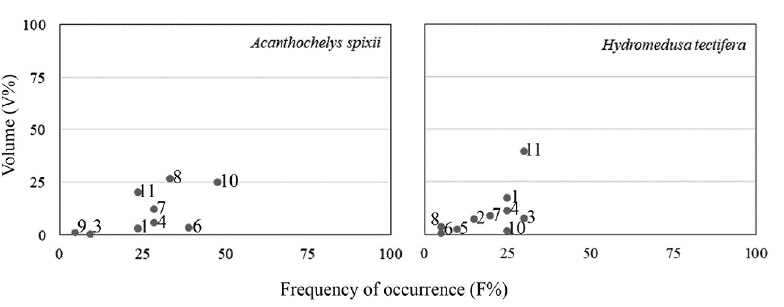INTRODUCTION
Freshwater turtles of the family Chelidae are represented in Brazil by about 20, mostly carnivore, species (Souza 2004, Costa and Bérnils 2018) that are important in the energy flow between aquatic and terrestrial ecosystems. Acanthochelys spixii (Duméril & Bibron, 1835) inhabits marshy areas in eastern Uruguay, northeastern Argentina and in the Brazilian states of Bahia, Goiás, Brasília, Minas Gerais, Paraná, Rio Grande do Sul, Santa Catarina and São Paulo (Lema and Ferreira 1990, Brasil et al. 2011, Rhodin et al. 2017, Sánchez et al. 2019). Hydromedusa tectifera Cope, 1870, inhabits many types of environments even on highly urban impacted water ecosystems (Bujes and Verrastro 2008) along southeastern Paraguay, central and north eastern Argentina, almost all Uruguay and in the Brazilian states of Minas Gerais, Paraná, Rio de Janeiro, Rio Grande do Sul, Santa Catarina, and São Paulo (Rhodin et al. 2017, Sánchez et al. 2019).
The diet of A. spixii is known only for Central Cerrado (Brasil et al. 2011) and southern Rio Grande do Sul (Assmann et al. 2013) populations. The main food items re-ported in these studies were immature and adults of different groups of insects together with small vertebrates such anurans, fish, and even algae and aquatic macrophytes. Knowledge about the diet of H. tectifera comes from central and eastern populations in Argentina. Its diet is composed by aquatic and terrestrial invertebrates, gastropods, leeches, crustaceans, fish, and even carrion among other items (Bonino et al. 2009, Alcalde et al. 2010). In view of the above, we emphasize that few studies have been addressed on the diet of both species in other environments such as southern Brazil, thus we present a contribution on the feeding habits of A. spixii and H. tectifera in this area contributing to the trophic knowledge of the species.
MATERIAL AND METHODS
The digestive tract, stomach and intestines, of 41 specimens of A. spixii (n= 21) and H. tectifera (n= 20), were examined for screening of food items. Freshwater turtles come from the municipalities of Pelotas (31°46' South, 52°20'West) (ten A. spixii and six H. tectifera), Capão do Leão (31°46' South, 52°26'West) (seven A. spixii and 14 H. tectifera), Rio Grande (32°10' South, 52°50'West) (three A. spixii) and Santa Vitória do Palmar (33°32' South, 53°20'West) (one A. spixii) municipalities, Rio Grande do Sul, Brazil. Thirty-nine turtles were collected dead in roads and highways of these municipalities, where they were run over. Two turtles were donated by the Wildlife Rehabilitation Center (NURFS/UFPel) because they died during the rehabilitation process, since they were cared for as a result of trauma by running over. The study was licensed by Instituto Chico Mendes de Conservação da Biodiversidade (ICMBio/N° 38913).
Once collected, turtles were packed in plastic bags and transported individually to the Laboratório de Parasitologia de Animais Silvestres (LAPASIL/UFPel), where they were frozen when it was not possible to perform the necropsy procedure soon after collection. The food items were identified at the lowest possible taxonomic level, quantified and conserved in ethanol 70°GL. The identification of animal items was performed with the help of Needham and Needham (1978), Mugnai et al. (2010) and Corrêa et al. (2015).
The food items were studied according to Hyslop (1980): frequency of occurrence (F %), which represents the percentage of the total number of digestive tracts in which a given food item was found, and the volume of the item (V %), which represents the volume, in percentage, of a given food item in relation to the total volume of all food items found in the digestive tract. Undefined insect remains, plant material and fine particulate matter were quantified by the Archimedes method of water displacement using a cylinder of 100ml (Souza and Abe 2000, Bonino et al. 2009) and the volume of the other items was estimated through the area (mm3) in a millimeter Petri dish (Hellawell and Abel 1971). In this cases the volume was afterwards converted to milliliters (ml). From the frequency of occurrence (F%) and volume (V%) of each food item, the index of food importance was applied (IAi %) according Kawakami and Vazzoler (1980):
The trophic niche range was calculated for both species of turtles using the Levins standard index (Hurlbert 1978), which varies from cero, when the species consumed only one type of food, to one, when the species consumed multiple types of food, given by the following formula: Ba = [( ΣjP2 ij.)1- 1] (n -1)-1 where Ba = standardized trophic niche size; Pij = food item proportion jin the diet of the species i; n = total number of food items consumed. In order to investigate the food strategy of the species, the graphical method of Costello (1990) was applied, where the values of volume and frequency of occurrence were used, where the dispersion of points for the values of volume are displayed in the y-axis and frequency of occurrence in the x-axis. According to the method, the points near a maximum of both % volume and frequency of occurrence express the most dominant food items. Points close to maximum frequency of occurrence and lowest % of volume suggest consumption of low quantities of different prey items, being the species a feeding generalist, when the points are close to 1% frequency of occurrence and 100% volume indicates specialization in a particular food item. Finally, the comparison of diet between A. spixii and H. tectifera was per formed using the non-parametric Mann-Whitney test (P < 0.05), from the food item volume data matrix, using the PAST program (Hammer et al. 2001).
RESULTS AND DISCUSSION
Twenty-one turtles (51.2%), i.e. twelve A. spixii and nine H. tectifera, had food content in the digestive tract. A total of thirteen types of food items were identified, ten items for H. tectifera and eleven items for A. spixii, both of animal and plant origin (Table 1). The diet of the species was composed mainly by insects, represented by Hemiptera, Odonata, Coleoptera and Diptera. There was no significant difference in the volume of items consumed by both A. spixii and H. tectifera (Mann-Whitney test, z= -0.387, P = 0.69).
Table 1 Food Importance Index (IA¡%) of items consumed by Acanthochelys spixii and Hydromedusa tectifera in the southern of Brazil. * most representative food items in the diet of each species.

For A. spixii, insect remains and plant material presented higher IAi values (26.4% and 35.2%, respectively) (Table 1), both having higher contribution both in frequency of occurrence and volume (Fig.1a). On the other hand, Gastropoda (IAi = 17.4%), followed by Odonata 11.3% and fine particulate material 47.1 % (Table 1) stood out in the H. tectifera diet. The consumption of Anura by A. spixii and the fish Phalloceros caudimaculatus (Hensel, 1868) by H. tectifera, both with low volume and frequency of occurrence (Figs. 1a-b) is highlighted. The category of unidentified insects was composed of fragments of individuals collected mainly from the intestine of the turtles, which made it impossible to sort and quantify the samples.

Figure 1 Frequency of occurrence (%) and volume (%) of food items consumed by a. Acanthochelys spixii and b. Hydromedusa tectifera in the southern of Brazil. FPM = fine particulate material
In relation to the trophic niche range we observed low and very close values for A. spixii and H. tectifera (Ba = 0.41 and 0.39) suggesting a more restricted diet with uniformity in food consumption, however we highlight that a more restricted diet does not suggest a trophic specialization, because the availability of food items have variation in time and space. According to Tófoli et al. (2010) a given species may consume a specific food source, which may be available all time and widely in the environment, which is associated, for example, with traits of the ecosystem structure. The analysis of the food strategy using Costello's graph showed that both species presented a more general-ist food strategy, consuming several items with emphasis on insects (Fig. 2).

Figure 2 Food strategy by Costello's graphical method, where the the x-axis by the frequency of occurrence (F%) and on y-axis is represented by volume (V%) of food items consumed by Acanthochelys spixii and Hydromedusa tectifera, in the southern of Brazil. 1 = Gastropoda, 2 = Decapoda, 3 = Hemiptera (adults), 4 = Odonata (nymphs), 5 = Coleoptera (adults), 6 = Diptera (larvae and pupae), 7 = Undefined insect remains, 8 = fish (Phalloceros caudimaculatus), 9 = Anura (tadpoles), 10 = Plant material (seeds, roots, flowers, leaves and parts of stems) and 11 = Fine particulate material (FPM)
The results corroborate studies conducted with A. spixii in Brazil (Brasil et al. 2011, Assmann et al. 2013), where it was observed that items of animal origin had a greater contribution in the diet of the species. Assmann et al. (2013) analyzed the diet of twelve individuals and found abundance of Diptera composing the diet of turtles. Brasil et al. (2011) when examining the diet of 40 specimens, observed 29 categories of food items, among which aquatic insects were the most representative in the diet of A. spixii. Similarly, the diet of H. tectifera recorded in this study corroborates research conducted in Argentina, where Bonino et al. (2009) examined the stomach contents of 154 specimens and reported several groups of invertebrates, such as Trichoptera, Odonata, Gastropoda, and Ephemeroptera. Alcalde et al. (2010) analyzed the diet of 25 specimens and described a higher F% of Crustacea, Hemiptera, Diptera and Odonata. Bonino et al. (2009) considered that H. tectifera has a high plasticity in relation to the use of resources, which are obtained from different microhabitats. The occurrence of vertebrates such as anurans and fish, was observed in both species (Bonino et al. 2009, Alcalde et al. 2010, Brasil et al. 2011, Assmann et al. 2013), as well as plant material (Alcalde et al. 2010, Brasil et al. 2011), however the ingestion of plants was considered accidental by the authors.
The use of wild animals run over for diet studies can be an alternative to expanding the knowledge of the biology of some groups, such as freshwater turtles, which suffer a negative impact of road kills during the reproductive period, when animals are in search of spawning grounds or partners for mating. Acanthochelys spixii, for example, is listed on the IUCN Red List of Threatened Species in the low risk or Near Threatened category due to insufficient knowledge (IUCN 1996), since its biology and conservation status is poorly known. In this context, diet studies provide information for understanding the biology of the species and its trophic relationships, helping in the conservation of the organisms involved and their habitats.
















